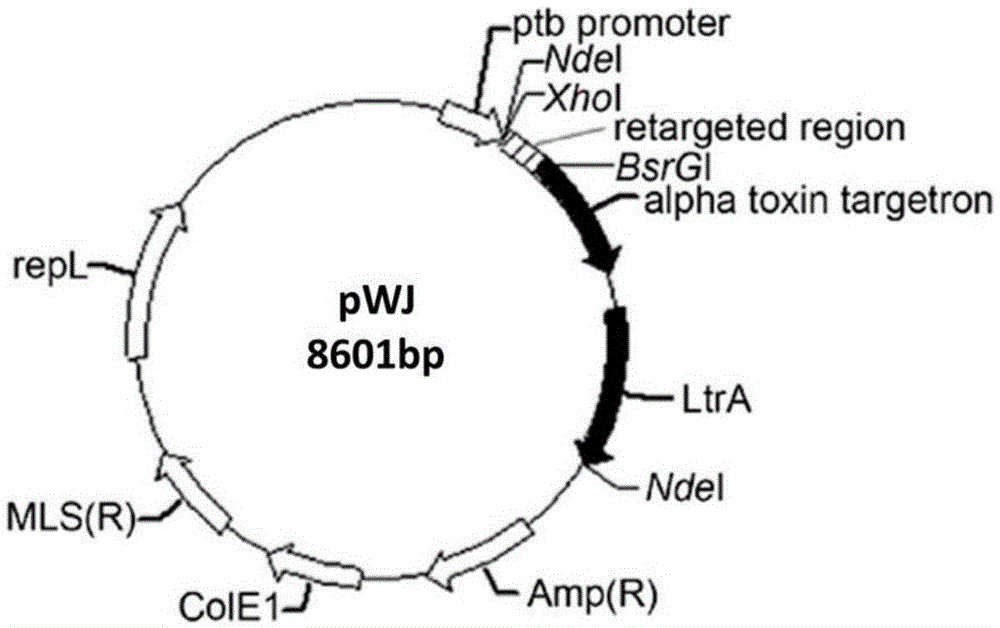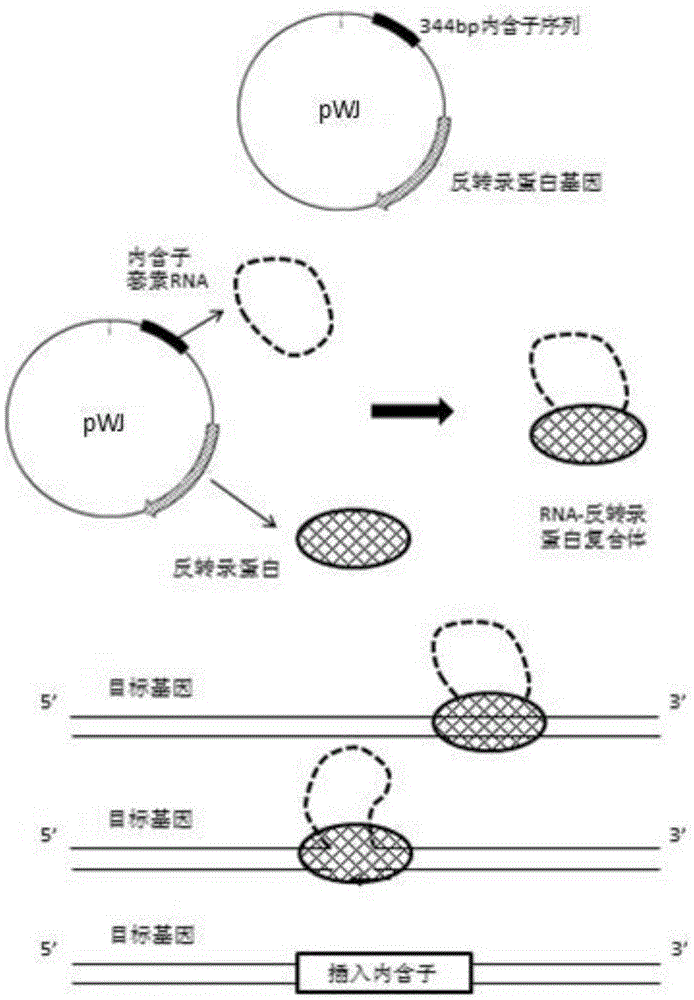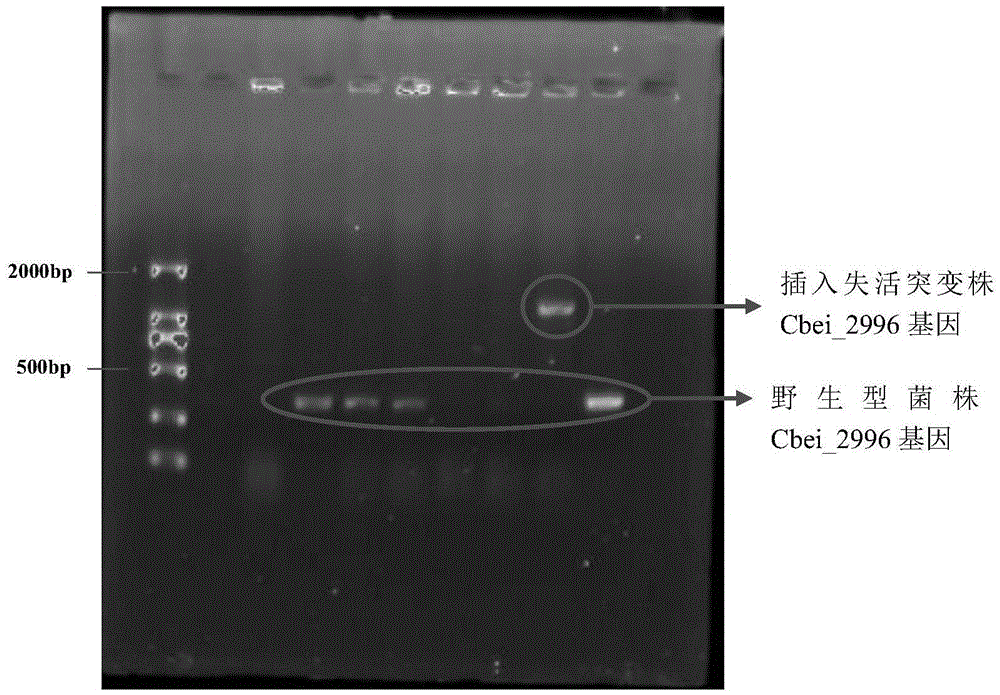Method for improving stress resistance of clostridium beijerinckii to 4-hydroxycinnamic acid
A technology of hydroxycinnamic acid and Clostridium beijerinckii is applied in the field of genetic engineering to achieve the effects of high stress resistance, improved stress resistance and high-efficiency stress resistance
- Summary
- Abstract
- Description
- Claims
- Application Information
AI Technical Summary
Problems solved by technology
Method used
Image
Examples
Embodiment 1
[0046] Embodiment 1: Construction method of Clostridium beijerinckii Cbei_2996 gene inactivation mutant
[0047] (1) Design introns:
[0048] According to the Cbei_2996 gene sequence of Clostridium beijerinckii included in the NCBI database (as shown in SEQ ID No: 1), that is, the base sequence (nuoA) encoding coenzyme Q oxidoreductase subunit A, the appropriate insertion gene site was designed with the help of software ( http: / / www.clostron.com), through the previous experimental screening and verification, it was selected to be inserted between the 62nd and 63rd bases of the Cbei_2996 gene sequence, and an intron sequence was generated, and the synthetic intron was S- 62, the sequence of which is shown in SEQ ID NO:2.
[0049] (2) Construction of Cbei_2996 insertion inactivation vector:
[0050]Use XhoI and BsrGI to double-enzyme-cut the vector pWJ (provided by Yang Sheng, Shanghai Academy of Biological Sciences, its sequence is shown in SEQ ID NO: 5, and the plasmid map o...
Embodiment 2
[0061] Embodiment 2: Passage stability of the recombinant bacterium of Cbei_2996 gene inactivation
[0062] The culture medium formula described in the present embodiment:
[0063] Plate medium: yeast powder 3g / L, peptone 5g / L, soluble starch 10g / L, ammonium acetate 2g / L, sodium chloride 3g / L, magnesium sulfate heptahydrate 3g / L, potassium dihydrogen phosphate 1g / L, Dipotassium hydrogen phosphate 1g / L, ferrous sulfate heptahydrate 0.1g / L, agar 15g / L, the rest is water, pH6.
[0064] Seed medium: yeast powder 3g / L, peptone 5g / L, soluble starch 10g / L, ammonium acetate 2g / L, sodium chloride 3g / L, magnesium sulfate heptahydrate 3g / L, potassium dihydrogen phosphate 1g / L, Dipotassium hydrogen phosphate 1g / L, ferrous sulfate heptahydrate 0.1g / L, the rest is water, pH6.
[0065] Fermentation medium: glucose 30g / L, ammonium acetate 2.2g / L, potassium dihydrogen phosphate 0.5g / L, dipotassium hydrogen phosphate 0.5g / L, sodium chloride 0.01g / L, magnesium sulfate heptahydrate 0.2g / L , fe...
Embodiment 3
[0071] Example 3: Investigation of the stress resistance of recombinant bacteria and starting strains to 4-hydroxycinnamic acid
[0072] Plate medium: yeast powder 3g / L, peptone 5g / L, soluble starch 10g / L, ammonium acetate 2g / L, sodium chloride 3g / L, magnesium sulfate heptahydrate 3g / L, potassium dihydrogen phosphate 1g / L, Dipotassium hydrogen phosphate 1g / L, ferrous sulfate heptahydrate 0.1g / L, agar 15g / L, the rest is water, pH6.
[0073] Seed medium: yeast powder 3g / L, peptone 5g / L, soluble starch 10g / L, ammonium acetate 2g / L, sodium chloride 3g / L, magnesium sulfate heptahydrate 3g / L, potassium dihydrogen phosphate 1g / L, Dipotassium hydrogen phosphate 1g / L, ferrous sulfate heptahydrate 0.1g / L, the rest is water, pH6.
[0074] Fermentation medium: glucose 30g / L, ammonium acetate 2.2g / L, potassium dihydrogen phosphate 0.5g / L, dipotassium hydrogen phosphate 0.5g / L, sodium chloride 0.01g / L, magnesium sulfate heptahydrate 0.2g / L , ferrous sulfate heptahydrate 0.01g / L, manganese...
PUM
 Login to View More
Login to View More Abstract
Description
Claims
Application Information
 Login to View More
Login to View More - R&D
- Intellectual Property
- Life Sciences
- Materials
- Tech Scout
- Unparalleled Data Quality
- Higher Quality Content
- 60% Fewer Hallucinations
Browse by: Latest US Patents, China's latest patents, Technical Efficacy Thesaurus, Application Domain, Technology Topic, Popular Technical Reports.
© 2025 PatSnap. All rights reserved.Legal|Privacy policy|Modern Slavery Act Transparency Statement|Sitemap|About US| Contact US: help@patsnap.com



